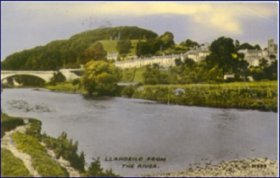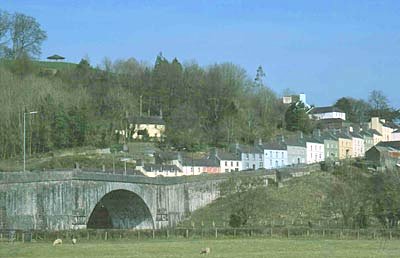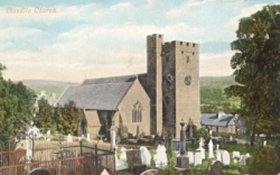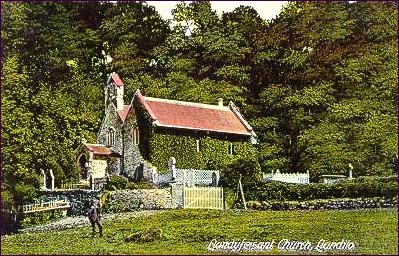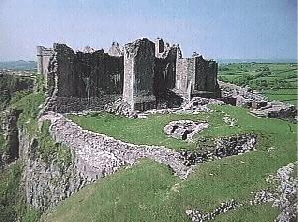Seat of Kings
Just seven miles north of Ammanford is the picturesque and ancient town of Llandeilo. There are several places of interest to see in the town itself as well as many others just a short drive away, so here is a brief history of Llandeilo and a description of some of its attractions.
View of Llandeilo from the River Towy Llandeilo is named after one of the most celebrated Celtic saints, St Teilo (the Welsh word "Llan means a religious enclosure). St Teilo was a contemporary of St David, the patron saint of Wales. He established a small monastic settlement on the site of the present day church in the 6th century. There are 45 places dedicated to St Teilo, some as far afield as Brittany, but Llandeilo is the most important. The early Christian settlement that developed around the church prospered and by the early 9th century it was the seat of a bishop-abbot.
The Church of Saint Teilo soon became a "mother church" to the surrounding district, acquiring an extensive estate and one of the principality's most beautiful and finely illustrated manuscripts – the Gospel Book of St Teilo. Towards the end of the 9th century the importance of Llandeilo as a spiritual centre had started to decline and the Gospel Book of St Teilo was removed to Lichfield where it became known as the Lichfield Gospels and Book of St Chad. The bishops of Lichfield still use this manuscript to swear allegiance to the crown. Llandeilo's progress through the medieval period is intimately linked to the fortunes of Dinefwr Castle, the traditional seat of the Welsh kings and princes of Deheubarth (which roughly coincides with the former county of Dyfed – or present day Carmarthenshire, Cardiganshire and Pembrokeshire).
The remains of Dinefwr Castle, which occupies an impressive site less than a mile from the town, date from the 12th century. The presence of an outer ditch and an earth embankment also support the theory that an Iron Age hill fort once occupied the site. Dinefwr was a centre of military and administrative control.
In 876 AD it was the residence of Rhodri Mawr, one of the greatest of the Welsh kings, a man of culture who promoted scholarship and art. In the 10th century Dinefwr Castle next became the seat of Hywel Dda (Hywel the Good), grandson of Rhodri Mawr. Medieval Welsh law books say that Hywel Dda called an Assembly at Whitland around the year 942. He summoned six men from every region of the Kingdom – on a scale larger than anything ever seen before in Wales. Their purpose was to consider the laws of the land.
The resulting manuscripts of Hywel's laws, in Latin and Welsh, formed the basis of our law in Wales until 1536 when Henry the Eighth merged Wales into England in the Act of Union of that year.
Dinefwr Castle in the 12th century became the capital of the most famous Lord of Deheubarth, the Lord Rhys, who led Welsh resistance against the Normans and was responsible for much of the present castle's stonework. Lord Rhys was also a prominent cultural figure and held a music and poetry festival in Cardigan in 1176, the forerunner of the modern Eisteddfod.
By the early 12th century Llandeilo was one of the most important towns in medieval Wales. Its prosperity can be inferred from the high levels of annual rent paid by the 30 local burgesses to the diocese of St David's. Llandeilo was granted a weekly market and was sanctioned to hold three annual fairs.
In 1403 the town was attacked and largely destroyed by Owain Glyndwr, which is perhaps another indicator of the town's strategic importance.
Until the mid 19th century St Teilo's Fair was held annually in the churchyard, a tradition stretching back to 1290. Some of the agricultural produce and other goods were displayed in the tombstones. On the day following St Teilo's Fair a smaller event was held at nearby Ffairfach (whose name translates as "small fair"). History, however, seems to be inherently mischievous and while Llandeilo's market closed in the 1980's the patronisingly named Ffairfach or 'small fair' still operates.
Life of St Teilo
Little is certain about the life of St Teilo, but he was probably born into a noble family at Penally near Tenby around 500 AD. His real name was probably Eliud, although he appears in Latin as Teliarus, in Breton as Teliau, and in French as Télo. He studied under St Paulinus at Whitland, where he met St David. The two saints, together with St Padarn, are said to have made a pilgrimage to Rome (or Palestine, depending on which version you believe) where they were consecrated as bishops.In 547 Wales was struck by the yellow plague, and St Teilo and his followers fled to Brittany where they stayed for seven years. Teilo is often depicted riding on a hart or stag. One legend tells of how St Teilo and St Aeddan were reading in the cloister at St David's when they were called away to gather fuel. The two monks took their axes off to the woods where two tame stags helped them to carry the wood home.
St Teilo died at the Abbey of Llandeilo Fawr, but his final resting place is a matter of dispute. Llandeilo, Penally and Llandaff Cathedral each lay claim to his remains; in order to satisfy all three, his body is said to have miraculously multiplied after his death!
View of Llandeilo bridge from the south with the picturesque houses of Bridge Street. The Stone Bridge
Most visitors arrive in Llandeilo courtesy of its spectacular stone bridge, the biggest of its kind in Wales, which was built in 1848 after an earlier four-arch wooden bridge was swept away by flood debris. It is the longest single arch stone bridge in Wales and while there are other stone bridges in Wales which are longer, they are multiple arched; other single arch bridges may also be longer but these are suspension or metal constructed bridges.The stone bridge was designed by local stonemason William Williams and built by Morgan Morgan of Cwmamman at a cost of £22,000. It's 363 feet long, 26 feet wide and 47 feet high, with a central arch span of 145 feet – and yet it looks like it's a part of the landscape. One 19th century observer described it as "the finest stone bridge in Wales, and one of the finest in the kingdom, and well harmonising with surrounding magnificent scenery.' They certainly don't build them like that any more.
The effect is enhanced by the terrace of pastel-painted cottages which line the bridge as it sweeps up towards the church.
Penlan Park
Penlan Park stands at the top of the town in the shadow of the famous twin stands of beech trees planted by Capability Brown. The park was donated to the people of Llandeilo by the 6th Lord Dynevor and was opened on June 11, 1908 by the peer's son, The Hon Walter Rice. A grand bazaar and fete was held with a variety of entertainments with luncheons, teas and suppers.The park is a good place to stroll and get a feel for the lie of the land, and the bandstand (which sits directly above the stone bridge) is still used occasionally. The park's entrance is tucked away at the side of the old grammar school (now a nursery) opposite the old market hall.
Church of St TeiIo
Web Site: http://www.llandeilofawr.org.uk/
Llandeilo has been a holy place for as long as Christianity has been in Wales. St Teilo, a contemporary of our patron saint, St David, was one of the most prolific of holy men and has places of worship dedicated to him throughout the Celtic world. This, however, is his spiritual HQ. The present church dates from the 13th century, although the main body was rebuilt in 1848-50. The only part to survive the Victorian makeover is the tower, a fine specimen of the square military towers of the county. The plans on display in the foyer of the church give an impression of how the church would look now if the money for rebuilding had not run out in 1850.
The older Church was a low mediaeval building, and described (admittedly by those who pulled it down) as "undistinguished by any architectural features". The present building was an ambitious construction which in its original form could seat 800 people. There's plenty to look at inside the church – including two medieval stone crosses, lots of fascinating inscriptions and an organ that used to grace Ripon Cathedral – but the abiding impression is that this is no museum – but a living, thriving, forward-looking church. There are big plans afoot to transform the interior with a £295,000 modernisation – for details see the church's excellent website on: http://www.llandeilofawr.org.uk.
Outside, the large churchyard was neatly bisected by the main road in the 1840s to allow coaches to travel safely through town (the old route was perilously hilly); any mortal remains unearthed were re-interred beneath the church. A final curiosity worth noting is Saint Teilo's Well, set into the wall of Church Street on the south side of the churchyard. A small passage beside the conduit leads to an underground chamber, through which flows a stream and forms a pool which is believed to be an ancient baptistry.
Dinefwr Castle and Park; Newton House
01558 823902 (National Trust) . Web site: http://www.nationaltrust.org.uk. Once you have opened the site, click on 'Places to Visit' and enter 'Dinefwr' in the 'Search by Name' box, then click on 'Search'.Dinefwr Castle was the 12th-century stronghold of Lord Rhys, and lords over the surrounding area on a thickly wooded naturally defensive promontory overlooking a lovely stretch of the Towy valley. Its most obvious feature is the splendid round keep which, thanks to extensive restoration, now dominates the southern approach to Llandeilo, and provides stunning views of the valley.
Just a mile downstream from Dinefwr castle can be seen Grongar Hill, a description of which can be found in the poem of that name by local-born poet John Dyer (1700-1758). As a poem Grongar Hill is very much of its time, where nature is used as an exemplum for human morals to imitate, but it has its charms nonetheless. Here's its conclusion:
A little rule, a little sway,
A sunbeam in a winter's day,
Is all the proud and mighty have
Between the cradle and the grave ...
......Oh, may I with myself agree,
And never covet what I see:
Content me with an humble shade
My passions tam'd, my wishes laid;
For while our wishes wildly roll,
We banish quiet from the soul:
'Tis thus the busy beat the air;
And misers gather wealth and care ...
......Be full, ye courts, be great who will;
Search for Peace with all your skill:
Open wide the lofty door,
Seek her on the marble floor,
In vain ye search, she is not there,
In vain ye search the domes of care!
Grass and flowers Quiet treads,
On the meads and mountain heads,
Along with Pleasure close ally'd,
Ever by each other's side:
And often, by the murm'ring rill,
Hears the thrush while all is still,
Within the groves of Grongar Hill.The advice still holds good in our own stressful times, perhaps even more so. Typically though, Grongar Hill is now private property and no-one is allowed access to its beauties, as was John Dyer all those years ago.
Dinefwr Castle is also a permanent reminder that Llandeilo was once a royal capital of Wales, seat of the Princedom of Deheubarth, the most powerful dynasty of its day.
Stroll back through the deer park and you soon arrive at Newton House (or Plas Dinefwr), the "new' castle. There has been a manor house on the site since the 15th century. Although the present Newton House dates back to 1660 and Sir Edward Rice – the great great great great great grandfather of the present Lord Dynevor – the house has substantial 18th-century and Victorian Gothic additions.
The grounds were remodelled by Capability Brown in 1775 in the fashion of the time – a carefully-controlled 'wilderness' of sweeping parkland punctuated by groups of towering trees. A series of death duties when the 7th Baron died in 1956, followed by the death of the 8th Baron only six years later in 1962, plunged the estate into crisis. Newton House has had something of an unhappy recent history and was sold by the present Lord Dynevor in 1974, suffering badly as a result and falling into near ruinous disrepair. It was occupied by squatters for many years and was stripped of many of its original features. Mercifully, both the mediaeval castle and Newton Huse have recently been restored by Cadw and the National Trust, who now run the park, its buildings and a tea shop. The National Trust acquired the deer park and the outer park at Dinefwr in 1987. Newton House was purchased by the Trust in 1990 having been through several hands since first sold by Lord Dynevor in 1974. The East Drive was acquired in 1992. The generosity of the Heritage Lottery Fund facilitated the purchase of Home Farm and Penparc in 2002. Dinefwr is now 286 hectares in extent.
For a more detailed history of Dinefwr Castle in this section of the web site, go back to the 'Places to Visit' section or just click HERE.
Llandyfeisant Church and Castle Woods Nature Reserve
Web Site: http://www.wildlifetrust.org.uk/wtsww/The Castle Woods Nature Reserve has been described as "….one of the most exciting woodlands in South Wales" by no less an authority than Peter Crawford, a senior producer with the BBC's Natural History Unit, in his book 'The Living Isles.' "The woodland is primarily oak and wych elm," he writes. "The shrubs and ground cover are outstanding with cherry, holly, spindle, dog violet and the parasitic toothwort. Lichen communities are of importance and include the rare lungwort. Overlooked by the romantic Castle of Dinefwr the fine old parkland has a herd of fallow deer. The mature trees attract woodpecker, redstarts and pied flycatchers. In winter the water meadows draw large numbers of ducks."
It's every bit as good as it sounds. The woods were purchased by the Wildlife Trust West Wales in 1979 and extend for dozens of acres along the steep slopes which rise from the Towy meadows up to the old Dinefwr Castle and to Penlan Park. The main access is from Penlan Park, but it's also possible to walk down the lane alongside the stone bridge over the Towy, following the marked paths indicated by the Badger footprint signs. Before long you'll come across Llandyfeisant Church, which lies in a delightful, sylvan, secluded setting at the heart of the reserve. This was regarded as the family church of the Lords of Dynevor, but had fallen into near-dereliction by the 1980s. It ceased being used for worship in 1961 when its font and stained glass window war memorial were removed to nearby St Teilo Church for safekeeping. The church has since been restored and served briefly as an information centre and shop though it is currently locked. A few yards away lie the ruins of the former vicarage, open to the elements now, and untended graves scattered under the slowly encroaching trees lend the scene a melancholy air tinged with a little mystery. Not somewhere for those of a nervous disposition to find themselves as nightfall approaches, either.
Llandyfeisant Church is now buried even deeper in the surrounding woods. Date unknown but about 1910. The King's Bridge
This mini-suspension bridge (think Severn Bridge made of Meccano) was built in 1911 in honour of King Edward VII, although what he made of the accolade is unrecorded. It was designed to provide a pedestrian link between Llandeilo railway station and the Ffairfach – Llangadog road, and is still a good bet for a pleasant circular 2.5 mile walk around the valley floor. Incidentally, nobody ever calls it by its proper name – try asking the way to the 'Swing Bridge' or the 'Shaky Bridge' instead and you'll get there rather quicker.Carreg Cennen Castle
Trap, Nr Llandeilo 01558 822291
Carreg Cennen enjoys the most dramatic and wildly romantic setting of any castle in Wales. The fortress teeters at the top of a limestone crag a few miles east of Llandeilo, plunging 300ft vertically into the River Cennen on the far side.
Its strategic importance has been valued for time immemorial: Roman coins and prehistoric skeletons have been found at the site. According to legend, a castle was built here by King Arthur's knights, one of whom is said to be asleep under the castle (one of a small army of legendary figures slumbering all over Wales, presumably awaiting Rhodri Morgan's call to rise up and liberate us).
The first "modern" castle was built by Lord Rhys, Prince of Deheubarth, in the late 12th century. The castle was soon betrayed to the English, won back by Rhys Fychan in 1248, then wrested back by Edward I in 1277.
The castle was rebuilt in the late 13th century and passed through a number of illustrious owners, including John of Gaunt and Henry Bolingbroke (later Henry IV), and was besieged and badly damaged by Owain Glyndwr in 1403.
The castle's owners backed the wrong horse during the Wars of the Roses, so the Yorkist victors dismantled the castle in 1461 to prevent it being used as a base for insurgence. The ruins have since been owned by Sir Rhys ap Thomas, the Vaughans of Golden Grove, the Earls of Cawdor, and, since the 1960s, by Bernard of Castell Farm, who has transformed the castle's farmyard entrance into a visitor attraction with tea rooms, a green oak barn, and a picturesque supporting cast of rare-breed livestock. The star of the show, however, remains the castle, which is maintained by Cadw. When you have finished admiring the stupendous views, hire a torch to explore a dungeon passageway which leads down into a cave deep beneath the castle.
There is a more detailed history of Carreg Cennen Castle in this section of the web site. Just click on 'Places to Visit' again or click HERE.
Links
Llandeilo Web Site Extensive history of Llandeilo from Roman times to the present. This is by far the best and most popular website for Llandeilo on the internet, averaging 8,000 visits a month. Llandeilo Community Council The local Parish Council for Llandeilo. The Dynevor Peerage One thousand years of History of the local Lord and his castle.
